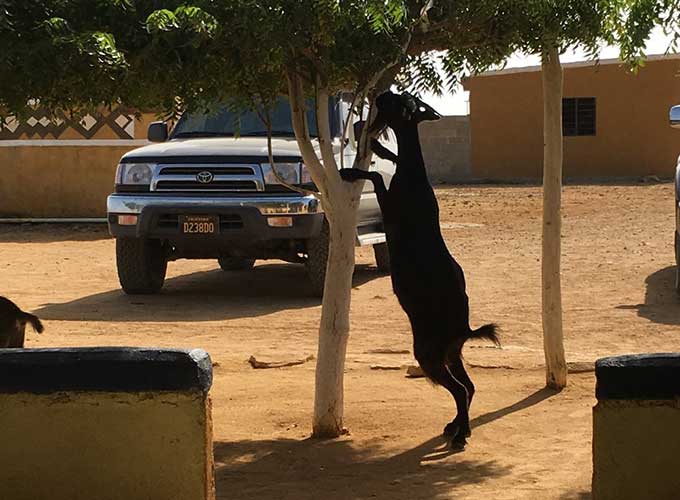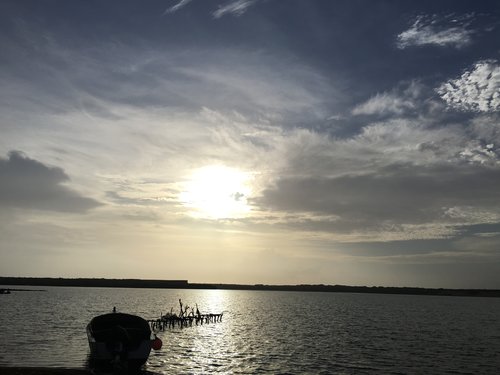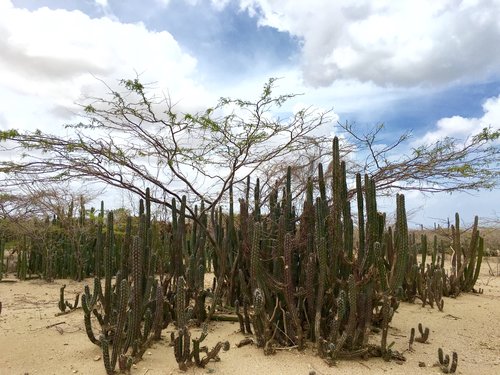Touring northern Colombia by car in the rainy season

There are many options for touring Alta Guajira, the northernmost part of Colombia (and of South America), but overlanding in your own vehicle is definitely choice. The only rub is that many of the roads aren't really roads so much as they are just the tracks of the last vehicle that passed through, and not necessarily in the direction you're headed. So, navigation is tricky for a local, and nigh impossible for a visitor.https://www.youtube.com/watch?v=x7a4QPSo8Cw
The various paths that lead to Punta Gallina are unpaved, rocky, and cut through a desert with infamously muddy patches that cars can be stuck in for up to a week. And driving through it during rainy season, as we did, can be especially treacherous.
We had a bit of "luck" on our side, if you can call it that. Unfortunately, the Guajira region has been subject to a five year long drought, making the difficult life of the Wayuu people who live there even more difficult. The UN and the Red Cross have both stepped in to try and alleviate the starvation and the lack of water, but providing aid has not been easy. So when we say "lucky," we mean only for the road quality, since we encountered little of the mud we'd been warned so vehemently about, and made it out with very little trauma to our 4Runner.
The other bit of luck we had was accidentally stumbling on a tourism agency that specializes in trips to Punta Gallina, while actually searching for different agency all together. That connection ended up being essential to the success of our trip, even though we did not ultimately utilize their services as guides.
Most tourists who visit this remote and sparsely populated region go either in a car driven by a local and guided by an English speaker. Or, they are driven to one of the only cities (here, the term is used generously, by city we mean perhaps more than 10 families live in a single area, with a few stores, and likely a kite surfing school or two) and are taken in a boat to other areas with more difficult overlanding logistics. This is a fine option. But you are shuttled from place to place, with little agency for things like choices in food and where to sleep. Likewise, you are sheltered from any kind of responsibility in the area, which was a fascinating, if often upsetting experience.
So when we told the first tour agency about our desire to drive ourselves out there, they were a little doubtful.
"You could," Paola said. But her confirmation of the possibility came with many caveats. About the lack of gas. About navigating the Wayuu rules of the road-- namely stopping at many self-appointed toll spots, where children swarm the car, and do not let you pass until you have given them cookies, or water, or sweets. About the roads, or lack there of, and about the difficulty of navigation.
But we were set on going, and so Paola gave us the perfect recommendation: Drive up to El Cabo De La Vela on our own, find the largest hotel in town (a ten room joint, with bucket showers and an adjoining outdoor restaurant) and ask around to see if there were any tours headed to Punta Gallina that we could follow. And so we did.
The road to Cabo De La Vela is 50% super easy-- paved, or when not paved, at least well trodden. And 50% difficult navigation through roads that make little to no sense, with a seemingly innumerable number of Wayuu toll stops. Our rations for the tolls-- treats, mostly, purchased from a grocery store in Riohacha-- dwindled much more quickly that we'd anticipated. And in a couple cases, we were very uncertain that we had headed in the correct direction. But we found the city, which is peaceful, and set against a still and tranquil coastline ideal for kite surfing.
Paola had called ahead to let her contact in Cabo De La Vela know we were coming. We were easily identifiable, as the only visitors to arrive in a car with California plates. And when Sergei, her contact, found us, he helped us find another tour guide with a group of five that were planning on leaving for Punta Gallina the next day.
That night, we camped on the beach, alongside many other visitors, who opted for the hammocks hung in palapas, the favored cheap lodging choice of the area. We purchased more toll fare from a local tienda. And, the next morning, we struck out for Punta Gallina.
We trailed a Land Cruiser VX from the Alta Guajira tour company, driven by a congenial man named Tobias. If you've prepped for overlanding, you're likely prepared for this journey. He lead us first to Punta Gallina's famous beach, which rests on the opposite side of a towering sand dune. The water is cool, and the sand is soft. It seems cast in unreality. We'd heard a dubious claim that the sand blew in from sandstorms in the Sahara, which just seems impossible. But it does have a completely different color and texture to the sand at all the other beaches in the region, and makes for a lovely sunning surface between bouts in the cool, blue water.
Then, he lead us to a tiny town, which is more a collection of houses surrounding one hotel-restaurant. It sits atop of a cliff overlooking a turquoise lagoon, replete with small collections of mangrove trees, a small dock, and an area in which they rear baby sea turtles for release into the wild. The town itself has more goats than people, no pavement, or even well trodden paths, and a preponderance of chickens. A few parrots live on the property of the hotel, and make the sounds of crying children, laughing adults, and a few wolf-whistles.
Tobias then lead us to a few choice scenic outlooks, two of which provided views of an enormous flock of flamingoes not too far away. And then, he lead us to El Faro Punta Gallina, the lighthouse that marks the northernmost point of South America. There, people have created an array of stone stacks on the beach to mark the spot, and we watched the sun set over them, casting weird and beautiful shadows across the sand.
As we headed back to the town, Tobias pulled to a halt, and pointed out a detonation crater. It was fifteen years old, he told us, and a relic of the government's war with Pablo Escobar. Escobar's illegal air strip had been just next to El Faro Punta Gallina, and the crater was created when the government bombed the area. It looked about three feet deep, and maybe ten feet across.
While the group that arrived officially with the Alta Guajira tours stayed in the hotel (which, they reported, was hot and stuffy, and not super comfortable) we camped below the cliffs just by the docks. It was serene, and silent save for the quiet sound of water lapping against the shore. A cool breeze blew gently all night. We slept like dead people.
The next morning, Alta Guajira tours had arranged for their guests to go on a quick boat tour to go look at flamingoes. The boat would drop them off at a farther location, that marked our point of exit from the area. So Adam followed Tobias in the cars, and I joined the boat tour, which led to a flock of about a thousand flamingoes. While I stared at the strange and improbable birds, Adam discussed logistics for getting to Valledupar with Tobias.
Of all the driving we've done so far, this has been the most satisfying. The route through the area cuts through salt flats, craggy desert, tiny Wayuu settlements, deep sand patches, cacti and shallow water. However experienced you are as a driver, we absolutely recommend tailing a tour group. The price for this service is tiny compared to the potential for the huge inconvenience of being stranded, lost, or stuck in the mud. Deep mud can often appear to be dry sand, and tricks even those familiar with the landscape. And driving in Wayuu country without a familiar face past 5pm is apparently not a great idea, for reasons no one made clear to us.
If you are planning a trip to the area, we also recommend the Alta Guajira tour company. Their services were excellent, Tobias's knowledge of the area was expansive, and also, he was just a nice dude. Bring along gas cans, filled in Riohacha, the last stop with true gas stations. Bring more cookies than you think you'll need, or better yet, bring bags of water. In retrospect, we wished we had brought water, which we hadn't realized was an option until too late. It is a more useful thing to give out in an area beset with difficult survival, drought and poverty,
If you are not planning a trip to the area, we highly recommend that you do.

Maggie Tokuda-Hall is the author of Also an Octopus, and the cohost of the Let's Not Panic podcast, which chronicles her trip in a Toyota 4Runner from San Francisco to Patagonia.








